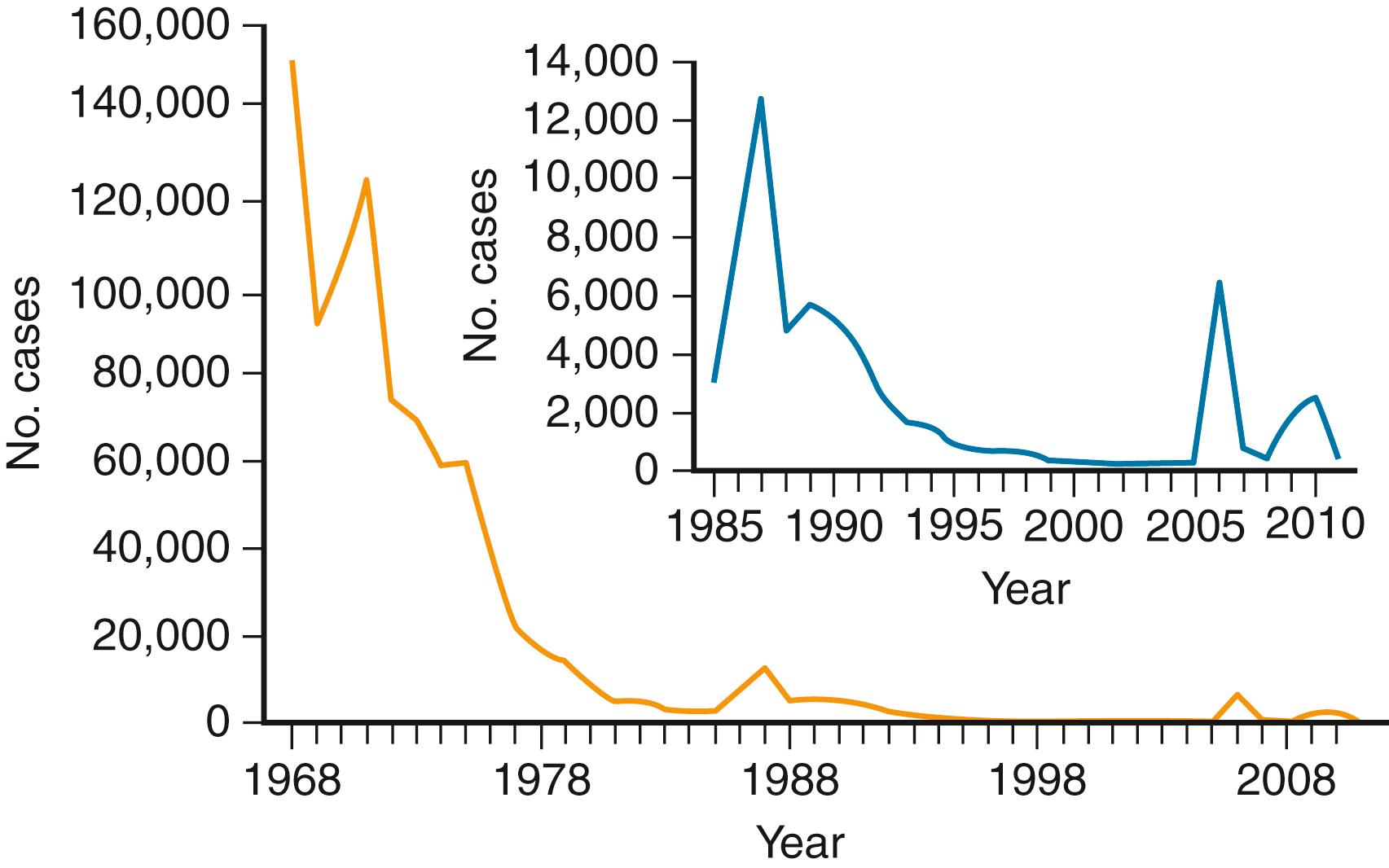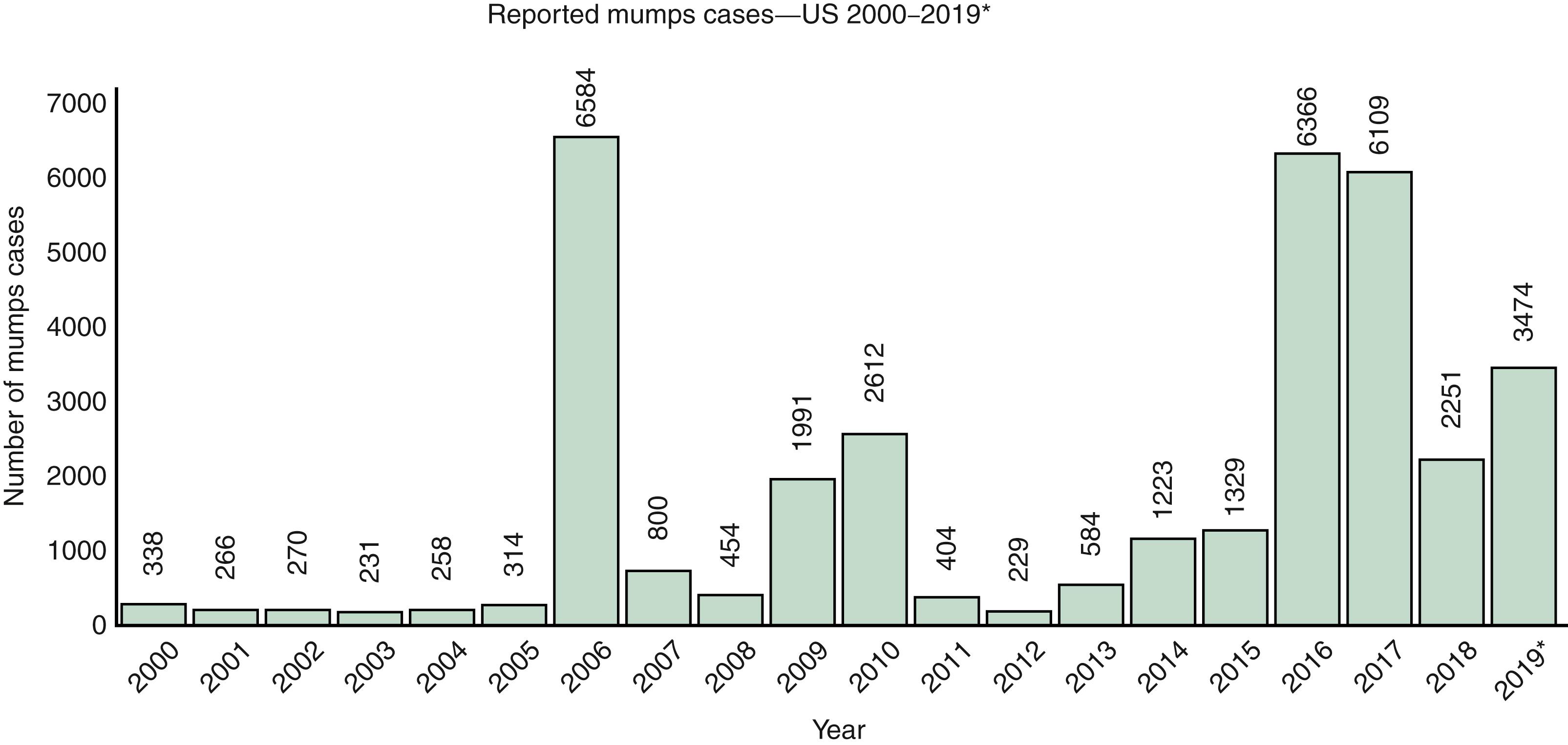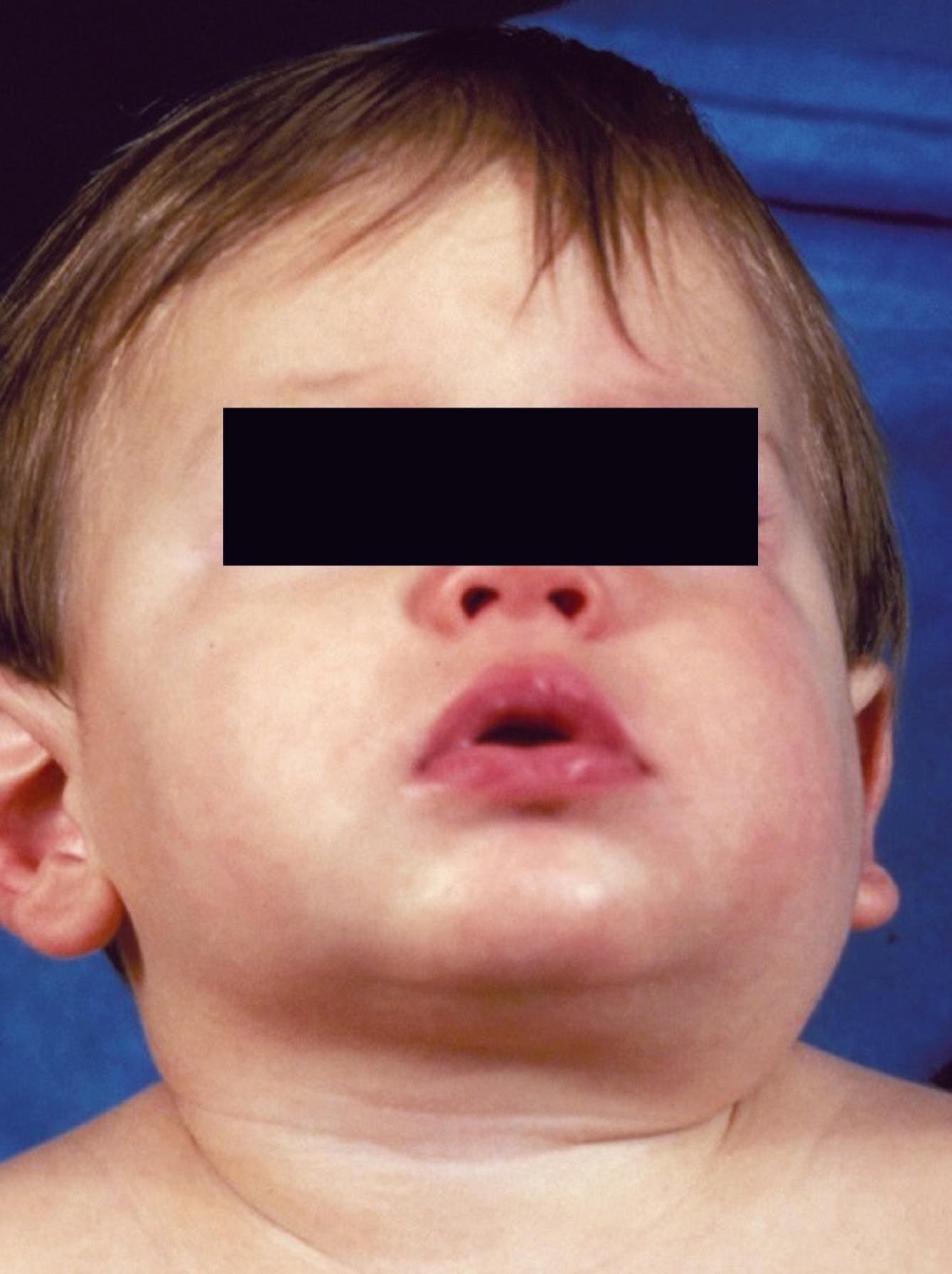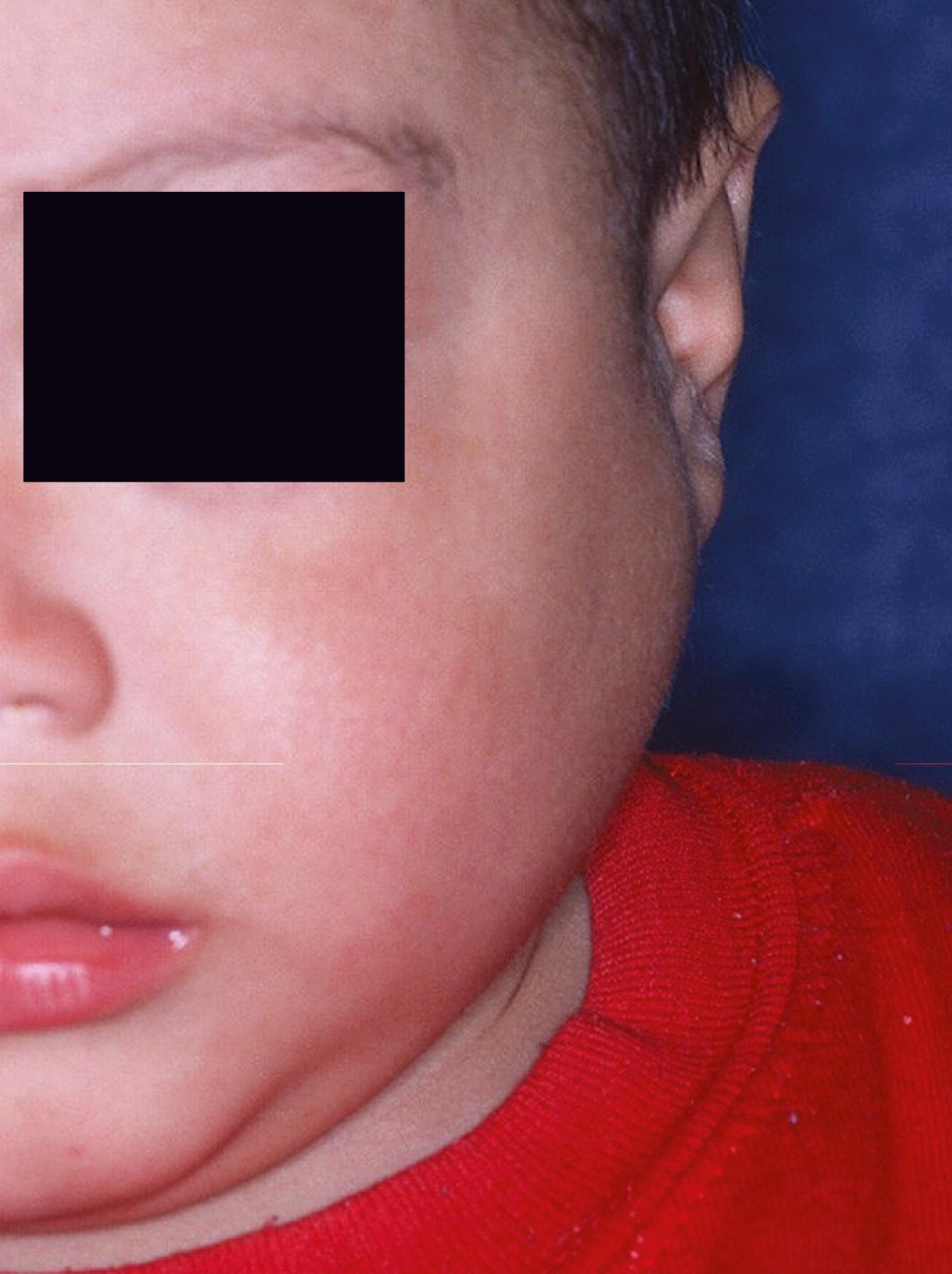Physical Address
304 North Cardinal St.
Dorchester Center, MA 02124
Mumps (i.e., epidemic parotitis) is an acute, vaccine-preventable disease of childhood that typically involves swelling of one or both parotid glands, although many different organs can be infected. Childhood mumps has become uncommon in the US since the widespread implementation of measles-mumps-rubella (MMR) vaccination. Reports of mumps outbreaks involving highly vaccinated populations in the US and other countries have prompted re-evaluation of current mumps vaccination strategies.
Mumps virus (MuV) is a member of the Rubulavirus genus in the Paramyxoviridae family. MuV has a single-stranded, negative-sense, nonsegmented RNA genome of 15,384 nucleotides. The viral genome is contained in a helical nucleocapsid enclosed in a trilayered envelope studded with two surface glycoproteins possessing hemagglutinin and neuraminidase (HN protein) and cell fusion (F protein) activities. MuV contains seven structural proteins, including a nucleocapsid protein, phosphoprotein, matrix protein, high-molecular-weight protein, small hydrophobic (SH) protein, HN protein, and F protein.
There is one serotype of the virus. The gene for the SH protein is the most variable part of the MuV genome. Based on the gene sequences for the SH and HN proteins, the MuV has been classified into 12 genotypes (A to L). , Molecular sequencing of SH and HN genes has facilitated identification of distinct MuV clusters and tracking virus transmission. MuV grows well in many human and monkey tissues and in embryonated eggs.
Mumps occurs worldwide and affects only humans; there is no animal reservoir. In the absence of vaccination, most people acquire infection by young adulthood. Epidemic parotitis is caused solely by MuV. In the prevaccine era, endemic mumps was most common in winter and early spring in temperate climates and frequently affected children aged 5–9 years. Although male and female infection rates are similar, males are more likely to have complications.
In the US, the reported incidence of mumps declined after the introduction of mumps vaccine in 1967 and recommendation for routine childhood immunization in 1977. After expanded recommendations for a 2-dose MMR vaccine schedule for measles control in 1989, mumps cases declined further. During the 2001–2003 period, fewer than 300 mumps cases (i.e., incidence of 0.1 case/100,000 people) were reported annually; this was a 99% decline from the 185,691 reported cases in 1968. However, an increase in cases occurred late in 2005 ( Fig. 224.1 ). ,

From 2006, several large-scale mumps outbreaks occurred in 2-dose vaccinated populations, especially among school-aged children and young adults in settings with high contact rates (such as college campuses and universities, close-knit religious communities, and certain ethnic subgroups). In 2006 a major mumps resurgence occurred in eight Midwestern states, resulting in 6584 cases (i.e., incidence of 2.2 cases/100,000 people). The MuV isolated was a genotype G strain. Almost 40% of patients were between 18–24 years of age and were mainly college students who had received 2 doses of MMR vaccine.
The public health burden of mumps remains substantial in the US ( Fig. 224.2 ). , Between June 28, 2009 and June 27, 2010, a large outbreak of 3502 mumps cases occurred in the Northeast. The source case was an 11-year-old US resident, who developed mumps while attending a summer camp in New York soon after his return from the UK. The outbreak occurred primarily among 2-dose vaccinated school students between 13–17 years of age, who were members of the tradition-observant Jewish community. Rates of mumps-related complications (e.g., orchitis, meningitis) were lower among 2-dose vaccinated students compared with students who had received 1 dose of the vaccine.

The resurgence of mumps involving highly vaccinated adolescent and young adult populations in the US led to discussions about new mumps vaccination strategies. , , , During 2016, large mumps outbreaks continued to occur, accounting for 6366 cases, including university outbreaks, close-knit communities, and other close-contact settings and community-wide outbreaks. Most cases occurred in young adults (median age, 21 years) despite high 2-dose MMR vaccine coverage.
Transmission of mumps within hospital settings can occur. Since patients are most infectious 2 days before and during onset of parotitis, transmission of mumps to others can occur from asymptomatic patients, especially in close-contact social settings. Mumps outbreaks highlight the importance of early detection and timely reporting of cases to health departments.
Mumps outbreaks among highly vaccinated adolescents also have occurred in the Netherlands, France, Belgium, and Australia. , Mumps immunity after childhood vaccination can wane by early adulthood, and this likely represents a key factor in the reemergence of mumps cases among highly vaccinated individuals. , ,
The incubation period of mumps is 16–18 days (range, 12–25 days). , An estimated 80%–90% of nonimmune household contacts become infected. Attack rates for development of clinically apparent disease have been substantially lower in outbreaks, especially for those who received 2 doses of MMR vaccine. Patients are most contagious 1–2 days before symptom onset and for 5 days thereafter; MuV has been isolated from saliva 7 days before symptoms and up to 9 days after the appearance of parotitis. Clinical and subclinical infections provide lifelong immunity; reinfection occurs rarely. Children with subclinical disease are infectious.
Mumps infection is acquired after direct contact with infected respiratory secretions, droplet spread, or contaminated fomites. Viral replication in the nasopharyngeal mucosa and regional lymph nodes is followed by primary viremia, which results in spread of infection to multiple organs, including the central nervous system (CNS), genital organs, and urinary tract. , The virus replicates in the glandular epithelium. Parotid gland pathology includes diffuse interstitial edema and serofibrinous exudate with infiltration of lymphocytes and macrophages. The ductal epithelium undergoes necrosis with intraluminal accumulation of lymphocytes and debris.
Orchitis results from direct MuV infection of the testes; MuV has been isolated from testicular biopsy specimens of the affected gland within the first few days of symptoms. Histologic changes within the testes include interstitial edema and lymphocytic infiltration. Focal destruction of the germinal epithelium can occur.
MuV infection of the CNS is common. The virus probably enters the CNS through the choroid plexus and infects the choroidal epithelium and ependymal cells lining the ventricles. Enlargement of the lateral and third ventricle (i.e., hydrocephalus) has been observed in animal models and humans. The pathogenesis of virus-induced hydrocephalus is postulated to be accumulation of infected ependymal cell debris in the cerebrospinal fluid (CSF). Mumps encephalitis occurs when infection spreads to the brain parenchyma along neuronal pathways.
Specific immunoglobulin M (IgM), IgA, and IgG antibodies are produced in response to mumps infection. The humoral immune response appears to restrict the plasma viremia. , Virus-specific secretory IgA appears concurrently with the cessation of viral shedding in saliva. The cell-mediated immune response to MuV includes T cells and interferon γ production. Intrathecal synthesis of mumps IgG and IgM antibodies has been demonstrated, along with production of interferon γ by activated cytotoxic T lymphocytes in the CSF. ,
One third of patients with mumps infection have subclinical or mild respiratory tract illness. The most common manifestation is painful parotid swelling (i.e., 95% of symptomatic patients), which usually is unilateral at the onset of illness and later becomes bilateral in 70% of cases. Prodromal symptoms, including fever, malaise, headache, and anorexia, typically precede parotitis by 12–24 hours. Earache on the side of parotitis and discomfort with eating or drinking acidic foods are common.
The swollen parotid gland lifts the earlobe upward and outward, and the angle of the mandible is obscured ( Fig. 224.3 ). The opening of the Stensen duct on the buccal mucosa is edematous and erythematous. Trismus can occur. About 10% of submandibular and sublingual glands can be affected. Presternal edema can be prominent. Morbilliform rash has been reported. Systemic symptoms, including fever, usually resolve within 3–5 days, and parotitis subsides within 7–10 days. Adolescents and adults have more severe disease than young children.

The differential diagnosis of parotitis is broad and includes bacterial (suppurative) parotitis, parotid duct stone, drug reactions, recurrent parotitis of childhood, parotid tumor, and Sjögren syndrome. Other viruses, such as Epstein-Barr virus, influenza, coxsackievirus A, echovirus, and parainfluenza virus types 1 and 3, can cause parotitis and are usually responsible for “recurrent mumps” ( Fig. 224.4 ). Children with human immunodeficiency virus (HIV) infection can have chronic bilateral parotid swelling that is not caused by MuV infection. Failure to use a strict case definition of mumps infection based on clinical and laboratory criteria or confirmatory laboratory testing can lead to an overestimation of the number of mumps cases in a population.

MuV is highly neurotropic, and CNS infection is the most common extrasalivary gland feature of mumps. Although CSF pleocytosis occurs in >50% of people with mumps parotitis, <10% have symptoms of meningitis. , Parotitis does not develop in about 50% of patients with mumps meningitis. MuV can be isolated from CSF in 40%–50% of patients with mumps meningitis.
CNS disease due to MuV is threefold higher in males than females. Meningitis is more common than encephalitis. , Encephalitis may develop in 0.1% of infections. Meningitis typically occurs 3–10 days after the onset of parotitis but can precede or occur without parotitis. Patients have fever, headache, vomiting, lethargy, and nuchal rigidity; 20% of patients have seizures. The CSF white blood cell count (WBC) usually is less than 1000 cells/μL, with lymphocytes predominating. The CSF protein level is normal or mildly elevated, and the CSF glucose concentration is decreased in 30% of cases. CSF pleocytosis can persist for prolonged periods, suggesting persistent infection.
In general, the course is self-limited with no sequelae, but ataxia, behavioral problems, aqueductal stenosis with hydrocephalus, and sensorineural deafness can occur. , In Japan, where mumps remains endemic because measles-rubella vaccine is used instead of MMR vaccine, the incidence of hearing loss among children with mumps is 1 case per 1000 people. Other rare CNS complications of mumps include cerebellar ataxia, facial palsy, ascending polyradiculitis (Guillain-Barré syndrome), transverse myelitis, and flaccid paralysis. , , About 1.4% of people with encephalitis die, and long-term morbidity is uncommon. , ,
Orchitis develops in 15%–30% of postpubertal males with mumps. , , Males between 15–29 years of age are at highest risk. Orchitis is uncommon in prepubertal males. ,
Symptoms begin 4–8 days after the onset of parotitis, but orchitis can occur before or in the absence of parotitis. Testicular involvement usually is unilateral, and epididymitis is associated with orchitis in most cases. Bilateral testes are affected in 15%–30% of cases of orchitis. Clinical findings include fever, malaise, vomiting, lower abdominal pain, and testicular pain. The testicle typically is swollen and tender for 3–7 days. MuV has been isolated from seminal fluid, and viral RNA has been detected in semen several weeks after infection.
Treatment of mumps orchitis is symptomatic, with bed rest and the use of scrotal support, ice packs, and anti-inflammatory agents. Complete recovery occurs in about 50% of males with mumps orchitis; 50% have some testicular atrophy. Infertility rarely occurs, although a decrease in sperm count and sperm motility can occur in up to 25% of patients. ,
Hematuria, proteinuria, and transient alterations in creatinine clearance can occur in children with mumps. Glomerulonephritis usually is self-limited, and death from renal failure is unusual.
Arthralgia, polyarticular migratory arthritis with effusion, and monoarticular arthritis are described. Signs usually appear 1–3 weeks after the onset of parotitis, but they can occur before or in the absence of parotitis. Joint complaints are threefold to fourfold more common among males, and the average age of occurrence is 24 years. , Large joints (i.e., knee, hip, wrist, ankle, and shoulder) are affected most frequently. The duration of joint symptoms ranges from 2 days to 6 months. Recovery with no evidence of persistent or recurrent symptoms is usual.
Electrocardiographic abnormalities consistent with myocarditis are reported in up to 15% of patients (often adults) with mumps. Abnormalities resolve within 2–4 weeks, although sequelae are reported. Reports of severe, fatal myocarditis are rare. ,
Pancreatitis can occur in about 4% of mumps infections and may cause mild epigastric pain ; severe hemorrhagic pancreatitis has been reported. The role of MuV in the development of insulin-dependent diabetes mellitus is controversial. Cases have occurred after mumps outbreaks, but no causal relationship has been established. ,
Oophoritis can occur in 5% of postpubertal women with mumps. Other rare complications include mastitis, thyroiditis, thrombocytopenic purpura, autoimmune hemolytic anemia, hemophagocytic syndrome, kerato-uveitis, and hepatitis with acute cholecystitis. , ,
Become a Clinical Tree membership for Full access and enjoy Unlimited articles
If you are a member. Log in here